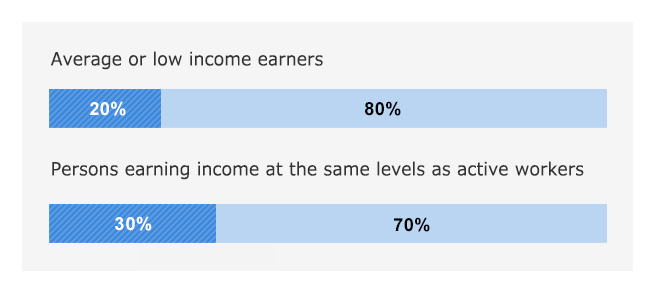Measures for reducing cost burdens for persons aged 70-74
The copayment rates and cost-sharing maximum amounts for medical care for persons aged 70–74 are lower than for persons less than 70 years of age.
- *When you reach age 75, you will become an insured person under the Medical Care System for the Advanced Elderly.See herefor more information.
- Description
- FAQ
Copayment rate for medical care costs
The copayment rate for medical care costs for elderly persons aged 70-74 is lower than for persons under 70 years of age. Note that those using a Myna health insurance card don't need to present an elderly benefits cards to receive examinations and treatment.
- * From December 2, 2024, elderly benefits cards will in principle be issued to those who have an Eligibility Verification Certificate. (Up until December 1, 2025, they can be issued to those who have a valid health insurance card.)
The copayment rate for individuals aged 70–74

Cost-sharing maximum amounts for high-cost medical care
Cost-sharing maximum amounts for elderly persons aged 70–74 are lower than for persons less than 70 years of age.
A per-person cost-sharing maximum amount for outpatient care and a combined cost-sharing maximum amount for total outpatient and inpatient cost-sharing amounts per household apply in cases in which more than one member is covered under the same medical insurance plan within one household.
For high-cost medical care for which the total amount paid per household exceeds the cost-sharing maximum amount, you will be refunded the excess amount at a later date.
Caution:
We recommend using a Myna health insurance card. By doing so and consenting to provide your cost-sharing maximum amount information, you can limit the amount you pay to medical care institutions and other facilities to no more than the individual cost-sharing maximum amount even without a Certificate of Application of Maximum Copayment Amount.
Note that you will need a Certificate of Application of Maximum Copayment Amount in the following cases. If you need this certificate, apply in advance.
- When not using a Myna health insurance card
- Examination and treatment received at a medical care institution or other facility that has not adopted the online eligibility verification system
- When not using a Myna health insurance card and you are 70 or older and in the same income category as active workers Ⅰ or Ⅱ
- * Even when using a Myna health insurance card, those in the low income categorymust apply in advance for a Maximum Copayment/Reduced Standard Copayment Certificate to be treated as falling in the low income category.
| Category | Cost-sharing maximum amount | ||
|---|---|---|---|
| Per person (Outpatient) |
Per household (Outpatient and inpatient) |
||
| Persons earning income at levels comparable to active workers | The same income level as active workersⅢ (Standard monthly remuneration830,000 yen or more) |
252,600 yen+(medical care costs-842,000 yen)×1% [Frequent qualification of expenditures 140,100 yen] |
|
| The same income level as active workersⅡ (Standard monthly remuneration 530,000 yen - 790,000 yen) |
167,400 yen+(medical care costs-558,000 yen)×1% [Frequent qualification of expenditures 93,000 yen] |
||
| The same income level as active workersⅠ (Standard monthly remuneration280,000 yen - 500,000 yen) |
80,100 yen+(medical care costs-267,000 yen)×1% [Frequent qualification of expenditures 44,400 yen] |
||
| Normal | Standard monthly remuneration 260,000 yen or less |
18,000 yen <Annual maximum (August of the previous year to July): 144,000 yen> |
57,600 yen [Frequent qualification of expenditures 44,400 yen] |
- *When an eligible person qualifies for high-cost medical care benefits for at least three months of a 12-month period, starting with the fourth month, the cost-sharing maximum amount is reduced to the amount for cases of frequent qualification of expenditures.
- *During the month of an individual’s 75th birthday, he or she will be an insured person under both health insurance and the Medical Care System for the Advanced Elderly. For this reason, the cost-sharing maximum amount for that month will be halved on an exceptional basis. (This exception does not apply to individuals whose birthday falls on the first of the month.)
- *See here for information on the cost-sharing maximum amount for persons with low income.
- Reference link
- When you incur high medical care costs
Column
Persons earning income at the same levels as active workers
Elderly persons earning income at the same levels as active workers are referred to as “persons earning income at the same levels as active workers.” The copayment for such individuals is 30%.
For health-insurance purposes, this refers to persons whose standard monthly remuneration is 280,000 yen or more. However, persons meeting either of the descriptions below may apply to the Health Insurance Association to be treated as persons with normal income levels.
- Those in a household consisting of two or more elderly persons with a combined annual income of less than 5.2 million yen (or elderly persons living alone whose annual income is less than 3.83 million yen)
- Those for which the judgment criteria for annual income have changed from those for a multi-person household to those for a single-person household because a dependent becomes an insured person under the Medical Care System for the Advanced Elderly and who are therefore judged to qualify as persons earning income at the same levels as active workers
Persons in the earlier stage of old age
Elderly persons aged 65 through 74 are referred to as “persons in the earlier stage of old age.” Since most persons in the earlier stage of old age are covered by National Health Insurance, a system of financial adjustment between health insurance systems has been introduced whereby health insurance associations and other insurers with low percentages of persons in the earlier stage of old age will cover the cost of benefits for persons in the earlier stage of old age.
There is no frequently asked questions and answers that have been registered.





